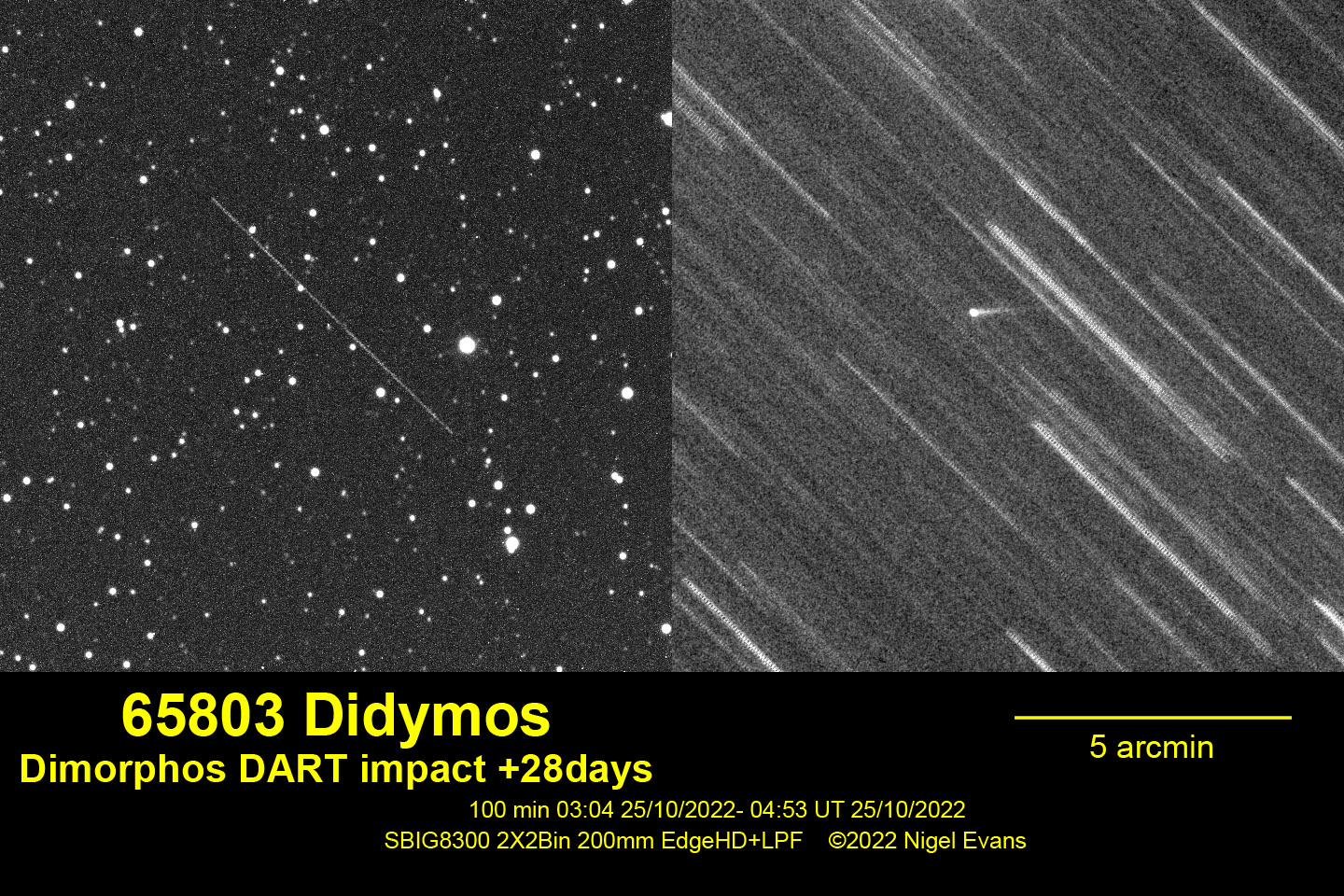
Orwell Astronomical Society (Ipswich)
Debris Trail From Asteroid Moonlet Dimorphos, 25 October - 30 December 2022
On 26 September 2022, NASA's DART (Double Asteroid Redirection Test) spacecraft collided with the asteroid moonlet Dimorphos. The manoeuvre was designed to demonstrate that the orbit of the body could be altered slightly. This was intended as a demonstrator of technology which could potentially be used to deflect a body on a collision course with the Earth.
Dimorphos is approximately 160 m in diameter and, prior to the collision, orbited its parent body, the asteroid 65803 Didymos, approximately 780 m in diameter, in 11 hours and 55 minutes. The impact velocity of DART was 22,500 km/hr and the collision reduced the orbital period of Dimorphos by approximately 32 minutes. The impact blasted many tons of debris from the surface of Dimorphos, forming a comet-like tail streaming behind the body into space.
Images by the Italian LICIACube (Light Italian Cubesat for Imaging of Asteroids) probe, released by the DART spacecraft before the collision, by the Hubble Space Telescope, the James Webb Space Telescope and large ground-based observatories showed the trail of debris. An image on https://spaceweathergallery.com/indiv_upload.php?upload_id=189328 by a UK amateur with a 315 mm aperture telescope, demonstrated that the trail was within the grasp of amateurs.
On the morning of 25 October, I imaged Didymos with a much smaller telescope, aperture 200 mm. I stacked 100 one minute exposures. In the LH pane below, the exposures are aligned on the stars, so the motion of Didymos makes it appear as a streak; in the RH pane, the exposures are centred on Didymos, so the stars appear as streaks. The RH pane gives the best chance of discerning the debris trail. I had been unsure if any trace of the latter would remain some four weeks after the event and I was pleasantly surprised at how prominent the trail appeared. Didymos was visible at magnitude 15.9 at a distance of 14.5 million km from Earth. The debris trail appeared approximately 1 arcminute in length, equating to a linear size of 4200 km.
The following video is constructed from the exposures used to create the above image. The first half tracks the stars, the second the asteroid.
The morning of 02 November presented another opportunity to image the debris trail. On this date, the asteroid was climbing into the northern sky but also receding from Earth. It will reach declination +30° in January 2023 when it will transit around midnight. It will be interesting to see if the debris trail has dispersed by then...
On 15 December, I decided to see how the trail of debris had evolved, so I imaged the asteroid again. Results are below; as previously, in the LH pane, images are aligned on the stars, and in the RH pane, on Didymos.
The RH image appears to show two tails, both just visible on close inspection of the image! The trail stretching from Didymos to the upper right is clearly caused by the star near the end of the trail in the LH view. The trail stretching from Didymos to the right, rising only a little above horizontal, however, might be the remnants of the debris trail, or could just be a pattern in the background. I need another clear night to take some more images! By way of comparison, see the BAA website for an image of the debris trail, taken by Grant Privett on 23 December.
On the night of 29-30 December, I used my new camera, a ZWO ASI6200mm, to capture two series of images of Didymos, with the camera set to 0°C for the first series and to -10°C for the second (part of ongoing experimentation to find the optimum setting for my use). The processed images are below and a faint trail is still clearly visible in both, 87 days after impact.
The image below is constructed from the two series of images above after 4x4 binning to try to further highlight the debris trail. (The original images were already 2X2 binned, so this required a second 2x2 binning.)
Nigel Evans